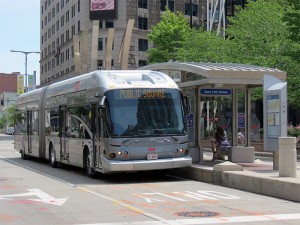 Growing up in New York, I both enjoyed and took for granted public transportation. My friends and I would often take the train into the city, and use the subway to get around pretty effortlessly. To a suburban adolescent, public transit meant freedom. But to society at large, it means sustainability.
Growing up in New York, I both enjoyed and took for granted public transportation. My friends and I would often take the train into the city, and use the subway to get around pretty effortlessly. To a suburban adolescent, public transit meant freedom. But to society at large, it means sustainability.
That word gets thrown around a lot, especially around Earth Day (April 22). The idea of wanting to pass along what we have to our children and future generations is an ancient one. What is different now is the realization that even vast resources are finite, and the size and scope of human activity has reached the point where it threatens our ability to do so. We often think of sustainability in environmental terms: reducing the negative impact of human activities on nature. But the concept of sustainability also includes social and economic dimensions. What we ultimately want is for our community – which is a local ecology of people and environment – to thrive both now and into the future.
There are many threats to sustainability, ranging from pollution and loss of open space to segregation and the cycle of poverty. While there are many efforts to address individual challenges, some of the problems are so interlinked that they require a more comprehensive approach, such as regional planning. It is exciting to see that in our little corner of the world, such planning efforts are underway by the MRMC (Milwaukee Regional Medical Campus, where Children’s Hospital of Wisconsin is located) and the city of Wauwatosa. One emerging component is bus rapid transit (BRT), which has the potential to address all three components of sustainability.
BRT is a modified bus system, using existing city streets. Buses travel in dedicated lanes, make fewer stops, use pre-paid tickets, and have the ability to modify traffic signals as they approach, all intended to decrease travel time and increase predictability. (That’s the “rapid” part. Contrary to some concerns among residents, they are not giant vehicles screaming down the local streets, just regular buses moving at regular speed.) It’s a way of having many of the advantages of rail at a lower cost. One of the potential benefits include fewer cars on the road, meaning lower emissions, less traffic, and fewer acres and dollars consumed to create parking. (One spot in a parking garage costs approximately $20,000 to build.) But it also increases the transportation options making the BRT destinations more attractive and accessible to diverse travelers. This includes those for whom car travel is economically or otherwise unfeasible, as well as those (increasingly including the millennial generation) who choose not to drive. (Increasingly I put myself in the latter group. Not only do I bike to work year-round, but Lynn and I may be the only people we know to have taken the Milwaukee County bus to the black-tie Swan Ball at the Pfister Hotel years ago.)
Places like the MRMC – like the mid-20th century vintage campuses of corporate giants such as General Motors and IBM, and the more soulless late-20th century office parks that litter the suburbs of every American city of any size – are important economic engines for our region. But to be sustainable, they need to not only have a lower water and carbon footprint, they must be better woven into the fabric of the community. We need to become more of a campus and less of a fortress. We need to become a destination, and a welcoming one at that. BRT would be a step in the right direction. One my millennial sons would undoubtedly use.

